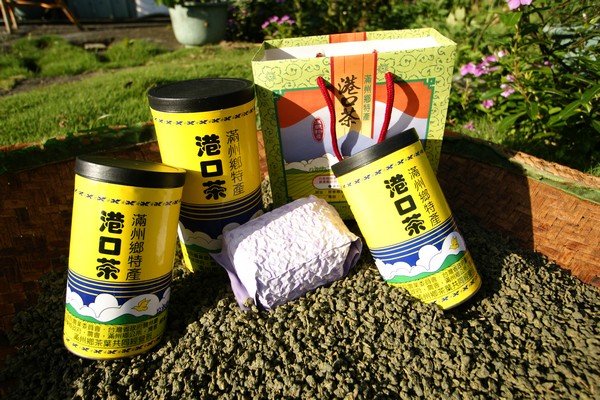Specialty of Port Tea


A layer of white powder covers the surface of Port Tea after the roasting of Port Tea, it is one of the specialties of Port Tea! At the very beginning, there was only the Chu Family cultivating the Port Tea since tea was a luxurious product during the Japanese Reigned Period. The situation gets even worse during the first years of R.O.C period. The public couldn’t afford drinking tea for they didn’t even have money for their every-day food. The situation began to change during President Chin Kuo Chiang’s era, when the economy gradually turned better in Taiwan. Along with the promotion of tea and the advantages of drinking tea better known, tea progressively gets more important. During that time, Port Tea also had its share-- migrators from Hsin Chu county to Manjhou started to cultivate Port Tea. Nevertheless, since the (poor) land and (windward) terrain, a lot of people failed.
A Different Reproduction Method

Port Tea is also named “the crossbreed tea” for its reproduction method. Since its breeding process includes tea seeds, every grown tea plant is different. Ms. Sho-Chu has been guarding the traditions of the Manjhou Port Tea; she doesn’t abandon the old way of reproducing just to pursue the unity of quality. Every sip of Port Tea reminds people of the hardship of life in Manjhou Township, however, after such reflection, the Port Tea also helps people to retain the positive power and create one’s own way. This reproducing method also helps to avoid the possible typhoons during the breeding season. The breeding time for Port Tea starts from the Winter Solstice and last for one year before the seedlings are grown and could be transplanted. However, in Taiwan, typhoon season occurs from July to September every year. If the typhoon comes when the seedlings are still too young, there usually left no seedlings at all when it leaves. From our ancester’s words, cultivating the tea by tea seeds could help avoid such situation. This cultivating method is indeed an inheritance of the wisdom of life.
The Ten Best Tea

Port Tea had participated the National Tea Competition and was selected one of the ten best teas in Taiwan. Port Tea is not only famous in Taiwan, but also abroad. The first time we heard that the Port Tea is also famous outside Taiwan, we were very confused. There are two reasons: one for Jialeshuei is a must-see spot for surfing and therefore attracts lots of foreigners to experience. Seeing the Port Tea there, they often wonder why tea could be cultivated at a place so close to the sea. Therefore, they bought Port Tea for a try. A lot of them fell for the Port Tea ever since then. The other reason is that during the Japanese Reigned Period, some of the aristocrats enjoyed drinking Port Tea so much that these Japanese people and their offspring keep coming back to Taiwan only for purchasing this tea.
Despite All Awful Environmental Factors
The most valuable thing about Port Tea is that it is the exception of the southern part (in fact, the south end) of Taiwan, where barely any tea plants could be cultivated. With the razing sun, the blowing downslope wind, the high occurance of typhoons and the salty seawind, the climate in this region is way too different from an usual tea-cultivating area. Despite all disadvantages, Port Tea is born there, and thus assures its uniqueness and value.
We also talked about the soil quality. Ms. Sho-Chu told us that after several years of tea planting, the soil aging problem appears. As soil quality is a crucial element of the tea cultivation, it becomes an emergency to solve this texture problem. The best way would be to choose a new yard, but a place where is suitable for tea in Manjhou is hard to find; since this region locates in the protected area of Kenting National Park, no planting could occur before completing the appropriate applying procedures. Though Kenting National Park helps promote the Port Tea to the tourists to know and to taste, its regulation of land usage limits the possible development of the Port Tea. Therefore, the farmers could only choose the second solution: dig the field over and mix the organic fertilizer with the soil. Granpa Chu says that even it is not as effective as a planting in a new yard, this method helps the soil to refresh as well.
Living with Nature


Why could the Port Tea be planted in Manjhou when there are so many disadvantages (typhoons, downslope wind, dryness…) for tea trees? Ms. Sho-Chu’s answer relieved our doubt. Manjhou area not only has very special landforms but also unique climate. People often connect Kenting National Park with the typical tropical climate, but actually it is not very “typical.” Since the Central Mountains lies across Manjhou, a special wind is brought-- the downslope wind. Besides the downslope wind, there is also “downslope rain” which only comes at night. The heavier the rain, the harder the wind blows the next day. They bring more water to the area so it’s not as dry as people imagine it would be, and the tea plants therefore grow well here. The climate of the western part and the eastern part of Taiwan appear at Manjhou at the same time. We can often spot rain in some areas while the sun shines brightly in others. As for the most “beloved” enemies like typhoons and downslope wind, people could only try to find a solution by themselves. All tea gardens in Manjhou which master in planting Port Tea are located in the leeward slope in order to avoid the intrusion of typhoons and downslope wind.
Ms. Sho-Chu told us before we left that she is always concentrated on the things at hand, like Port Tea. She always puts all her mind in researching and making the best out of them. The kind of people Ms. Sho-Chu likes the least is those who never complete their jobs. For giving up in the half way, they don’t even need to start in the beginning. Ms. Sho-Chu also encourages us to leave our classrooms to explore more about the world. Moreover, we have to know the art of asking questions before we may become a “good student.”



